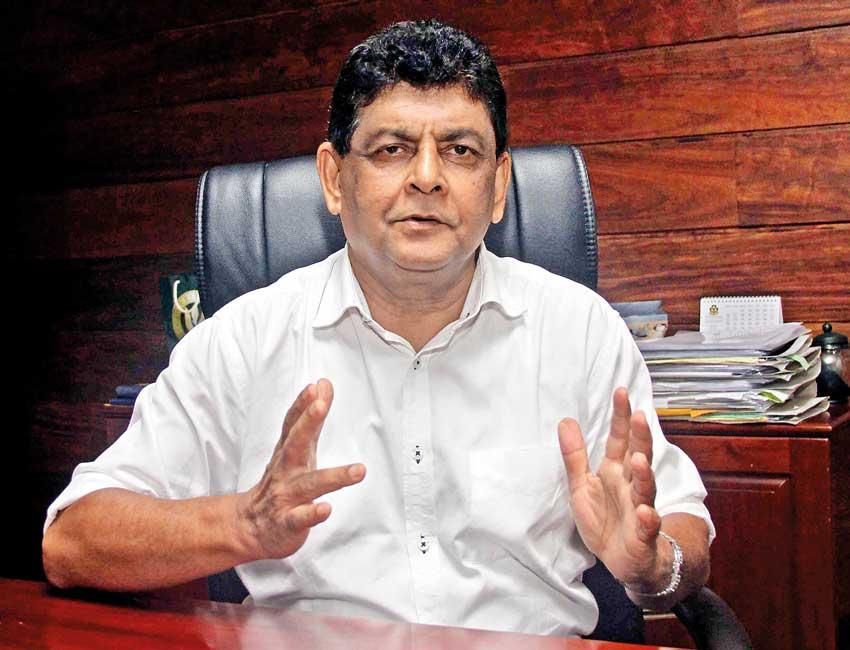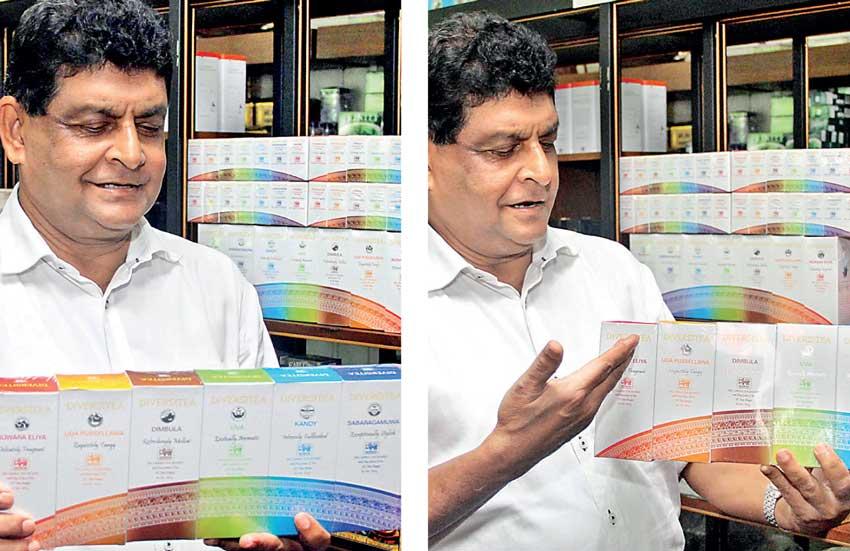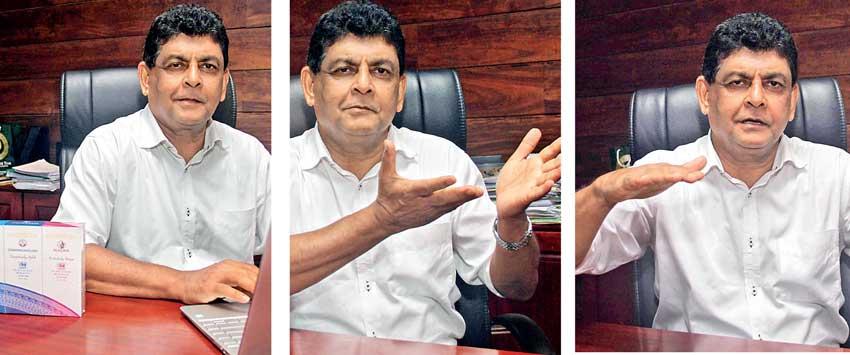Reply To:
Name - Reply Comment
Last Updated : 2024-04-19 05:18:00

Sri Lanka Tea Board Chairman Jayampathy Molligoda
Pic by Pradeep Dilrukshana
 Sri Lanka’s tea industry that has been in existence for over 150 years has certainly captured the world with its rich aroma. However, it continues to follow its old ways and that has led to a slowdown. From the maintenance of the bushes, plucking to transportation, the industry continues to follow traditional ways, leading to high cost of production, which places the sector in a rather challenging position amongst its competitors. The industry is now faced with reduced production, which is attributed to climate change and is striving to continue to offer premium ranges. All these require a fresh approach, given that the industry would now have to grapple with a fresh challenge, the new normal. Mirror Business recently sat down with Sri Lanka Tea Board (SLTB) Chairman Jayampathy Molligoda to gain some insights on the direction the industry is being steered towards. While he discussed the challenges faced and the efforts taken to move the industry forward, it is clear the private sector is expected to step up in lifting Ceylon Tea to greater heights.
Sri Lanka’s tea industry that has been in existence for over 150 years has certainly captured the world with its rich aroma. However, it continues to follow its old ways and that has led to a slowdown. From the maintenance of the bushes, plucking to transportation, the industry continues to follow traditional ways, leading to high cost of production, which places the sector in a rather challenging position amongst its competitors. The industry is now faced with reduced production, which is attributed to climate change and is striving to continue to offer premium ranges. All these require a fresh approach, given that the industry would now have to grapple with a fresh challenge, the new normal. Mirror Business recently sat down with Sri Lanka Tea Board (SLTB) Chairman Jayampathy Molligoda to gain some insights on the direction the industry is being steered towards. While he discussed the challenges faced and the efforts taken to move the industry forward, it is clear the private sector is expected to step up in lifting Ceylon Tea to greater heights.
Following are the excerpts from the interview.
Sri Lanka’s tea industry just about fared through the crisis period. However, it was not exactly gung-ho before that. We were struggling with quantities while striving to maintain quality. Is there a possibility of having the best of both?
There definitely is a possibility of having the best of both. If we start from the quality, that is from the fields, if they maintain the correct plucking route and the correct application of the best agricultural practices, then there can’t be any loss of production. We can have the best of both worlds, provided that the proper inputs are infused at the correct time.
Having said that, due to the climate change phenomena, the production can get affected and due to the seasonal fluctuation, this can get impacted as well on a month-by-month basis. It doesn’t matter as long as you maintain the optimal level of quality, not the maximum level.
Currently, we follow the B60 Leaf Programme route, which requires the pluckers to bring in no less than 60 percent of good leaves, we don’t ask for 100 percent quality. When we started 150 years back, we spoke of the ‘two leaves and a bud’ but now it is changed, where the third leaf also can be plucked. This is done to get the optimum productivity yield.
Therefore, we are striking a balance between the optimum quality and quantity. The factories and the fields are working in collaboration with each other in this regard.
It is imperative that we improve focus on product and quality management as the soil textures, tea bushes and the factories have lost their standards over the years
What is the current status of the industry? Are all the stakeholders satisfied with the path the industry is taking to move ahead?
The tea industry is handled by the private sector. It is not a government management. About 95 percent of the industry is in the hands of the private sector, leading about 456,000 so-called smallholders. They are not small, as they contribute about 70 percent to the annual national tea production.
Next in the supply chain are the tea factories, where they too are largely handled by the private sector. The eight broker companies and the exporters are also from the private sector, even the support services.
The board of directors of the Sri Lanka Tea Board are largely represented by the private sector stakeholders.
I think the stakeholders are somewhat satisfied. However, we have some issues with regard to the processing and export of value-added tea, due to challenges in getting down the workers to the factories and also getting the other materials.
I wouldn’t say there is a need for a post-COVID-19 recovery plan, as there is nothing to recover, other than fast-tracking our exports with more and more value-added lines and an aggressive global tea marketing strategy
As the industry is challenged in terms of quantities and to import other origin teas is not encouraged, local exporters have resorted to blending in other destinations and are exporting under the Ceylon Tea label. Does this have any implications on the pure Ceylon Tea brand?
I don’t think that statement is 100 percent correct. Temporarily, there may be issues in getting the quantities as our production has been slightly lower, so there is no serious issue of the non-availability of tea, at least black tea for the exporters.
We do allow the import specialty teas, though not all, in small quantities. I am not aware of the exporters manufacturing in other destinations but they can blend in other destinations. In some blending centres aboard they do this but it is not a big issue. This does not have any implications on the Ceylon Tea brand.
However, someone can export other origin teas as Ceylon Tea and we cannot always protect the label as a trademark, due to the laws in some countries. The infringements cannot be enforced.
Whilst we promote and nurture the expertise of our stakeholders, we need to support the newcomers in the industry, by assisting them in promotion
You are referring to the Geographic Indication (GI). What is the progress on that?
In order to get the brand registration of Ceylon Tea, like Champaign in France, we need to go through the intellectual property rights. The GI is done rather than the certification. Couple of years back, Sri Lanka applied for GI registration, which they couldn’t proceed. It is easier said than done.
We need to differentiate our product from the other origin teas. It is not just a tea taster job here. The relevant stakeholders have done quite a bit of work to convince the World Intellectual Property Organisation (WIPO) to prove Ceylon Tea is different through tea tasting.
My understanding is that it is not enough to convince the authorities. We need to have a scientific basis. We learn that the only way to get this is by going through the isotopes, which is more like a fingerprint.
The Sri Lanka Atomic Energy Board (AEB) is having some discussions internally for this. If this is coupled with the unique inherent character that is associated with the Ceylon Tea aroma and taste, then we will be able to apply to the GI.
We also need to look at the internal Intellectual Property Rights Act to see if it needs any amendments.

What is planned by the Tea Board for the industry? What are the strategies in place or the strategies that are being formulated to give the brand/product lines the due recognition in the international market?
From the product quality enhancement to having total quality management, up to the strategy of allowing very few imports of specialty and other origin teas and last but not least, the registration of the GI, all these that I mentioned so far are the strategies in place to take the industry forward. These are already in place to give Ceylon Tea its due recognition in the international market.
Coupled with this, we have the global tea marketing and promotion campaign stemming from our Ceylon Tea strategy; there we need to further go for nation brand visibility. Whilst we promote and nurture the expertise of our stakeholders, we need to support the newcomers in the industry, by assisting them in promotion.
We have a very good diversification of exporter and marketer portfolio, although there is a little less diversified product portfolio.
Controversies have followed the tea promotion fund, from the time it was set up in 2010. What are the plans for the disbursement of the same? Is the way it is being handled fair to those contributing to the fund?
Recently, with the minister’s approval, we have set up a Tea Promotion and Marketing Committee to discuss, deliberate and advice the Sri Lanka Tea Board on the way forward for the promotion. This fund is just a mechanism to draw money to spend on the global tea promotion campaign.
There has been some brand promotion and trade fair participations of the industry, which has been supported along with other campaigns. Reputed people have been appointed to handle this.
All of these efforts have been reviewed and we have appointed the exporters of different categories, along with the Tea Board director promotion and myself, to conceptualise some campaigns. We wanted to link the Ceylon Tea marketing strategy with the global promotional campaign. We have been debating and discussing about in the last two months or so. We are aggressively working on implementing the strategy.

While the promotion fund is certainly accumulating, the reality is that it is not being used in a productive manner. It is not being ploughed back to bring the desired outcomes. In that context, is there a need for the levy to continue?
What you say may be true in the past. We have over 200 exporters and in the past, all may have not benefitted from the fund. But as I mentioned, we now have a new committee that is represented mainly by the exporters and they are the people who represent the industry.
We take full responsibility and will take fair assessment of the campaign, which will be linked to the Ceylon Tea strategy. We will address the concerns of the exporters and we will do so in a different way. We have come to a consensus with them.
As for the need to continue with the levy, it is relevant; there is no issue there. We need to only ensure the realignment of the Ceylon Tea strategy with the global campaign, where we use the funds from the promotion levy.
We talk much of ethical manufacturing and sourcing but the plantation workers, without whom the industry wouldn’t even exist, in some way or the other are suppressed. Very little improvement they have seen in their livelihood for decades. What is the Tea Board’s view on this?
I would say that there have been substantial improvements to the livelihoods of the plantation sector workers. However, the critical success factors are on our sustainability credential; over here it is about the social sustainability.
I agree we need further improvement in the work life of the workers and that will really benefit the industry even from the economic point of view, although some consider this as a cost.
We are doing much better compared to other countries in this area; we provide medical care, we have zero tolerance on child labour and companies are working towards sustainability. The view of the Tea Board is that we need to improve further along these lines, as they are the backbone of the industry.
Also, what is the status of the collective wage agreement? Can the workers hope for an increment?
That is a matter between the regional plantation companies, state-owned plantations and unions, who are signatories of the agreement facilitated under the Employers’ Federation of Ceylon (EFC). The Tea Board is not directly involved in that.
However, under the law and Tea Control Act, we are closely watching the development to ensure that we achieve the sustainability of the tea industry and to ensure decent work life standards of the workers. We have recognised this as an obligation although we do not directly involve in the negotiations.
How about the 2020 export target? Is it revised now, given the global impact form the pandemic?
The export target is not revised as yet. We are in constant touch with the stakeholders and they are doing what is necessary to maintain market momentum and export orders.
Provided that all stakeholders across the industry continue to maintain the high quality, standards and deliver on time to the designated markets, the year-end target can be met.
An improved focus on value addition in the coming months is what would help the industry fetch higher earnings. Although the industry witnessed a 35 percent drop in export income via value addition, I am confident that the exporters will make up for what was lost by the end of the year.
My main concern is that due to climate change, the production has dropped. If the exporters can develop the market and get more orders, it will be good for the industry.
I notice that except for China, the USA, Germany and Iraq, in all other markets there has been a decline in market share. It will be a challenge for the exporters to regain the lost glory to get more export share. A number of reasons can be attributed to a drop in market share. We need integrated product quality and management.
It is imperative that we improve focus on product and quality management as the soil textures, tea bushes and the factories have lost their standards over the years.
With oil prices coming down, how is it going to impact the industry going forward? Over 50 percent of our teas are imported by the Gulf nations. So, with oil prices projected to remain low in the short and medium term, what will be the affect of that on our tea exports?
This was a concern to me as well and I have been asking our large reputed exporters, who continue to export our teas to the Gulf nations. Their response has been positive. What they say is that they will ensure that they get the same prices irrespective of the fluctuations.
Having said that, they say due to other reasons exports could be affected. We could lose market share in countries such as Iran, where it is difficult due to the sanctions.
Due to the oil price drop, they don’t see any major impact.
Any post-COVID-19 recovery plans? What will be done differently?
I wouldn’t say there is a need for a post-COVID-19 recovery plan, as there is nothing to recover, other than fast-tracking our exports with more and more value-added lines and an aggressive global tea marketing strategy.
I stress we need to maintain the sustainability credentials, since we have to live with the COVID-19 for a while. If we focus on environmental and social sustainability, people will recognise such effort. Unlike any other business, here there is a trickle-down effect right up to the farmer.
Through a reasonable price formula and looking after the well-being of the estate workers will have a long-standing positive impact. Post COVID-19, people will look for natural beverages. So, if we grab this opportunity, in two to three years’ time, we can get a greater market share in the natural beverage segment.
Prasanna Rajpal Kotalawela Friday, 12 June 2020 03:21 PM
What is total Re-Planting undertaken by the RPCs in both Tea
George. Vernon. Tissera Friday, 12 June 2020 04:33 PM
I think it is very Essential that every one is told how exactly they should brew a cup of tea. Many use boiled water, reboiled to brew a cup of tea, this is one example. I am sure every one will appreciate the proper method to be used that makes all the difference to a tasty cup of tea.

Add comment
Comments will be edited (grammar, spelling and slang) and authorized at the discretion of Daily Mirror online. The website also has the right not to publish selected comments.
Reply To:
Name - Reply Comment
On March 26, a couple arriving from Thailand was arrested with 88 live animal
According to villagers from Naula-Moragolla out of 105 families 80 can afford
Is the situation in Sri Lanka so grim that locals harbour hope that they coul
A recent post on social media revealed that three purple-faced langurs near t

46 minute ago
16 Apr 2024
10 Apr 2024